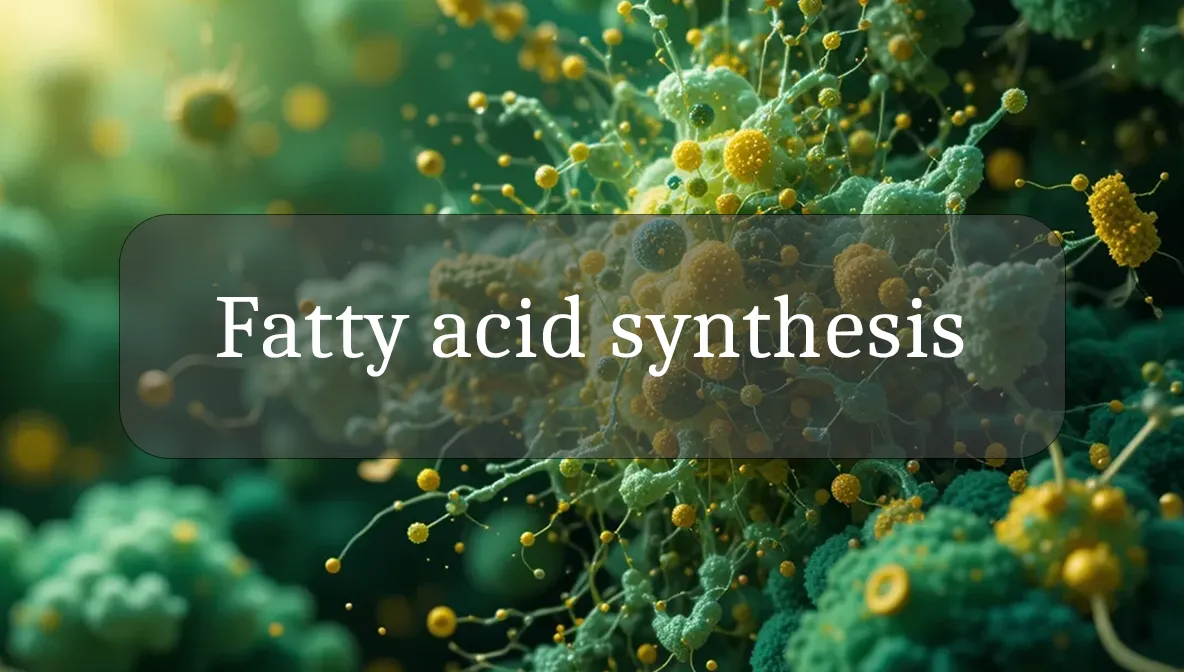Body’s Energy Storage Builder
Fatty acid synthesis is the process your body uses to create fatty acids, the building blocks of fats that store energy, build cells, and support vital functions. This internal factory is essential for keeping you energized and healthy, though balance is key to avoid excess fat buildup. Let’s explore what fatty acid synthesis is, its role in your wellness, and how to support it for daily vitality.
Identity and Function
Fatty acid synthesis is a biochemical pathway that occurs mainly in the liver and fat tissue, where your body converts simple molecules (like glucose or amino acids) into fatty acids. The process happens in the cytoplasm and starts with acetyl-CoA, which is transformed into long-chain fatty acids (like palmitate) through a series of enzyme-driven steps. The key enzyme, fatty acid synthase, orchestrates this assembly line. These fatty acids are then used to form triglycerides (stored fat), phospholipids (cell membranes), or signaling molecules.
Biological Role and Health Impact
Fatty acid synthesis is crucial for keeping your body functioning and resilient:
- Energy Storage: Fatty acids are stored as triglycerides in fat cells, providing a long-term energy reserve for when you’re active or fasting.
- Cell Membrane Structure: They form phospholipids, which build flexible, protective membranes for every cell, supporting skin, organs, and nerves.
- Hormone and Signaling: Fatty acids are precursors for signaling molecules (like prostaglandins), regulating inflammation, blood clotting, and immune responses.
- Brain Health: They support nerve cell membranes and myelin, aiding memory, focus, and brain function.
- Temperature Regulation: Stored fats insulate your body, helping maintain warmth and protect organs.
By producing fatty acids, your body ensures you have energy reserves, strong cells, and balanced signaling for overall health.
Production and Sources
Your body synthesizes fatty acids naturally, with diet playing a supporting role:
- How It’s Made: The liver and adipose tissue produce fatty acids from excess carbs (e.g., glucose from bread) or proteins via acetyl-CoA. Synthesis is most active after meals when energy is abundant.
- Dietary Influence: Carbs (grains, fruits) and proteins (meat, beans) provide raw materials for acetyl-CoA. Dietary fats (oils, nuts) reduce synthesis, as the body uses pre-made fatty acids instead.
- Key Nutrients: B vitamins (biotin in eggs, pantothenic acid in whole grains) and magnesium (nuts, spinach) support enzymes in the synthesis pathway.
- No External Sources: Fatty acid synthesis is an internal process; you don’t consume fatty acids as a supplement for this purpose.
A balanced diet with carbs, proteins, and healthy fats supports efficient fatty acid production.
Signs of Imbalance
Imbalances in fatty acid synthesis can lead to health issues, often tied to diet or metabolism:
- Excess Synthesis:
- Weight gain or obesity from overproduction of triglycerides, especially with high-carb, low-fiber diets.
- Fatty liver disease (non-alcoholic), where excess fatty acids accumulate in the liver, causing fatigue or abdominal discomfort.
- High blood triglycerides, increasing heart disease risk.
- Insufficient Synthesis (Rare):
- Dry skin, brittle hair, or poor wound healing if cell membrane production is impaired (usually due to severe malnutrition).
- Fatigue or hormonal imbalances if signaling molecules are lacking.
- Metabolic Issues:
- Insulin resistance or diabetes can disrupt fatty acid regulation, leading to fat buildup or abnormal blood lipids.
If you notice unexplained weight gain, fatigue, or liver-related symptoms, get blood tests (lipid panel, liver function) to check for imbalances.
Supporting Healthy Function
To keep fatty acid synthesis balanced and body-healthy:
- Eat a Balanced Diet: Include complex carbs (oats, sweet potatoes), lean proteins (fish, tofu), and healthy fats (avocado, olive oil) to provide steady energy without overloading synthesis.
- Choose High-Fiber Foods: Beans, veggies, and whole grains slow sugar absorption, reducing excess fatty acid production.
- Exercise Regularly: Aim for 30 minutes most days (e.g., jogging, cycling) to burn stored fats and improve insulin sensitivity, regulating synthesis.
- Limit Added Sugars: Avoid sugary drinks or processed snacks, which spike glucose and drive overproduction of fatty acids.
- Support Liver Health: Limit alcohol (1 drink/day for women, 2 for men) and avoid smoking to keep your liver efficient at managing fats.
Safety and Precautions
Fatty acid synthesis is a natural process, but health conditions or lifestyle factors require care:
- Medical Conditions: Obesity, diabetes, or fatty liver disease can disrupt synthesis, requiring dietary changes or medications (e.g., metformin). Work with a doctor to manage these.
- Medications: Statins or fibrates (for cholesterol) may indirectly affect fatty acid metabolism. Use as prescribed and monitor with blood tests.
- Hormonal Factors: Insulin resistance or thyroid disorders can alter synthesis. Discuss symptoms like weight changes with your doctor.
- Genetic Risks: Some people have genetic predispositions to high triglyceride production (e.g., familial hypertriglyceridemia). Screen if you have a family history of heart disease.
- Supplements: Avoid unproven fat metabolism supplements without medical advice; focus on diet and exercise first.
If you have high triglycerides, liver issues, or metabolic concerns, consult a healthcare provider for a lipid panel or personalized plan.
Fun Fact
Did you know your body can turn a slice of bread into fat? Excess carbs from that toast get converted into fatty acids in your liver, stored as energy for later—like a biological savings account!
Citations
- National Institutes of Health (NIH): Fatty Acid Synthesis and Metabolism.
- Mayo Clinic: Triglycerides and Heart Health.
- Cleveland Clinic: Understanding Fatty Liver Disease.
- American Heart Association: Lipid Metabolism Guidelines.
- Journal of Lipid Research: Fatty Acid Synthesis Pathways (2020).

